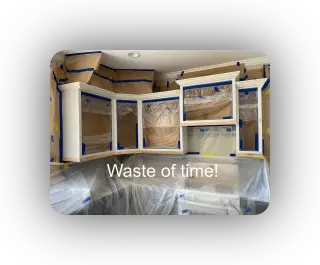Spray painting cabinets on walls is not how we paint your cabinets
While painting kitchen cabinets can be a rewarding DIY project, there are several common mistakes to avoid to ensure a professional-looking finish.
Image

Image

- Skipping the Prep Work: Failing to properly clean and sand the cabinets before painting can lead to poor adhesion and a rough finish. Always clean with a degreaser and sand to create a smooth surface for the paint.
- Ignoring Primer: Primer is essential for ensuring the paint adheres well and lasts longer. Skipping this step can result in chipping and peeling paint.
- Using the Wrong Paint: Using low-quality or incorrect type of paint can lead to a less durable and unattractive finish. Always use high-quality, low VOC paints specifically designed for cabinets, like Benjamin Moore's acrylic paint.
- Rushing the Drying Process: Paint needs adequate time to dry and cure between coats. Rushing this process can cause smudging, uneven coverage, and a sticky finish.
- Not Removing Hardware: Painting around hardware instead of removing it can lead to messy edges and a less professional look. Always remove handles, knobs, and hinges before starting.
- Painting in Poor Conditions: Painting in high humidity or extreme temperatures can affect the drying and curing process. Choose a well-ventilated, temperature-controlled area for the best results.
- Skipping Sanding Between Coats: Lightly sanding between coats ensures a smooth and even finish. Skipping this step can lead to visible brush strokes and an uneven surface.
- Using the Wrong Tools: Using brushes and rollers that are not suited for cabinet painting can leave streaks and uneven coverage. Invest in high-quality brushes and rollers designed for a smooth finish.
Avoiding these common pitfalls can help you achieve a beautiful, professional-looking finish for your kitchen cabinets. If you have any questions or need more tips, feel free to ask! 🌟